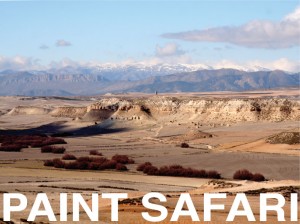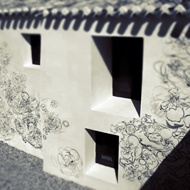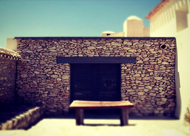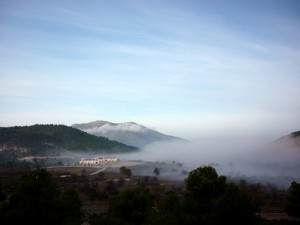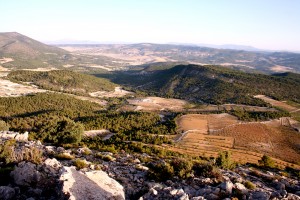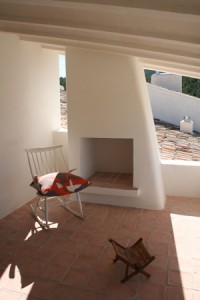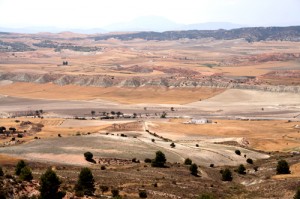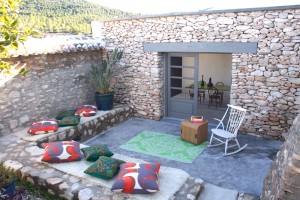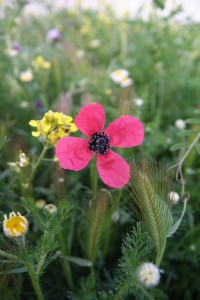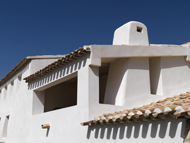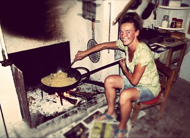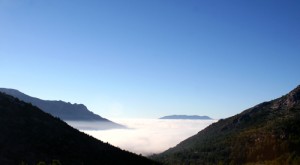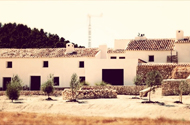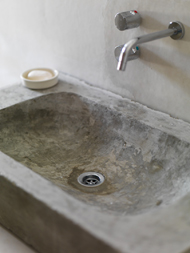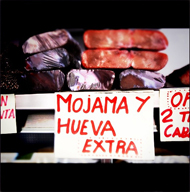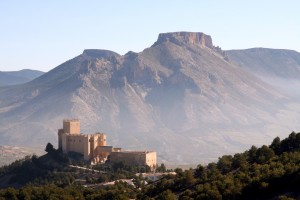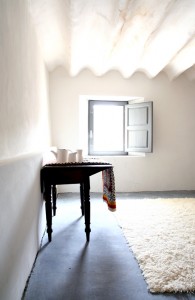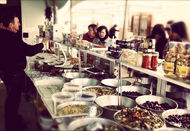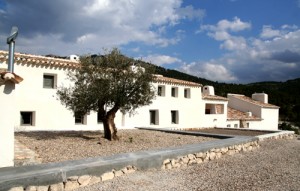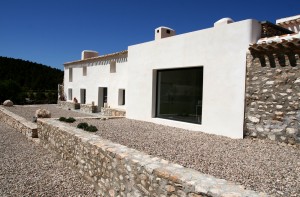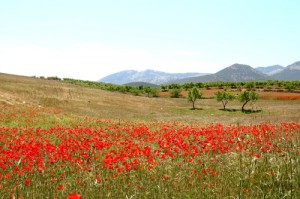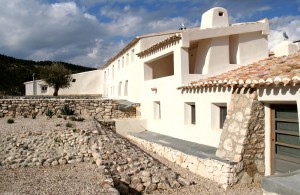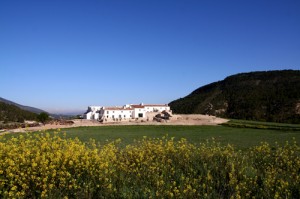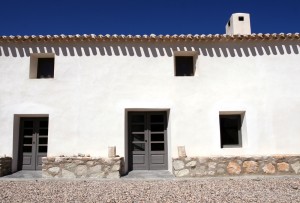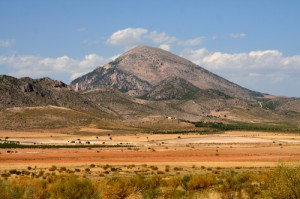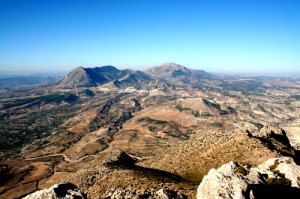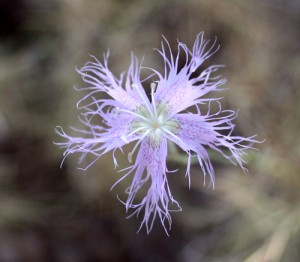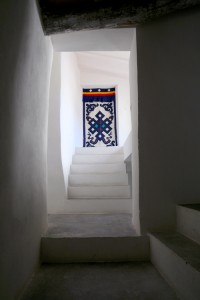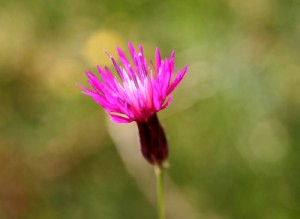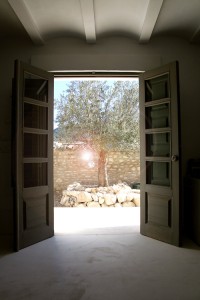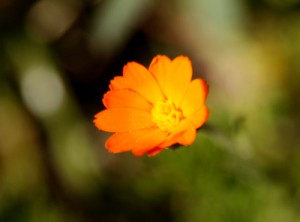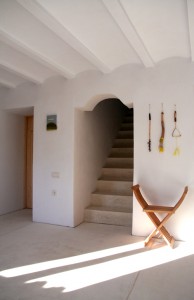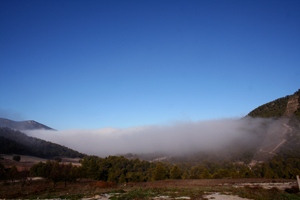May 31, 2008 at 8:31 am
· Filed under Landscape, Vida los Velez
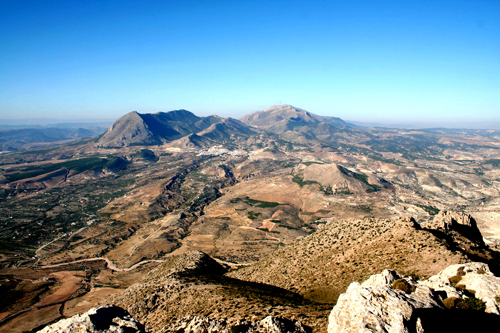
This is the view west from the top of ‘La Muela’ (1553m/5095.14ft). In the foreground you can see the ‘Rambla de Rio Claro’ and above the pueblo, ‘Velez Blanco’.
The mountain to the left is the ‘Sierra de Maimon’ (1504 m/4934.38ft) and the larger one to the right is the ‘Sierra de Maria’ (1898m/6227ft). To put that into a British perspective ‘Snowdon’ is 1085m/3560ft.
The green to the left is ‘Blanco Valley’ and the olive groves. Olive groves irrigated by the miracle of water which pours from naturally occurring springs in ‘Velez Blanco’ and are the main reason the ‘Moors’ first settled here. This ‘spring’ water gives the pueblo some fame with people coming from miles around to collect the water.
To the right is the Alpine desert, arid but for the spring rains.
Permalink
May 30, 2008 at 5:20 pm
· Filed under Landscape
Permalink
May 29, 2008 at 8:09 pm
· Filed under Librarius

I recently introduced the twins to Asterix. Tintin they have seen as DVD animation but they have not read the books. Asterix in a cartoon strip is something else. Now this is an age old debate similar to saying…
“Did you like the Beatles or the Rolling Stones?” Well for me it’s got to be Asterix. When was Tintin ever funny? They have one thing in common however and maybe it’s a product of their generation, but they were very fond of racial stereotypes.
I’ve got to say though in this instance they were spot on. Ave Caesar, ave Asterix.
P.S. I liked The Doors
Permalink
May 27, 2008 at 7:16 pm
· Filed under Environment

As I confessed earlier I hated ‘print making’. The very idea of creating an image and then reproducing it multiple times back to front always seemed a bit odd to me. And clearly my tutors were geniuses telling me that all I had to do was conceive my art work back to front in the first place and then the subsequent results would be the right way around. Sure!
However, Albrecht Durer was a genious, producing multitudes of ‘wood cuts’ like these. These were the times of the ‘Black Death’ so I would assume that it would be natural for artists (commissioned or otherwise) to create images of our final hours because that would have been how it appeared when up to 40% of some cities succumbed to the plague.
What’s more, I don’t think I would be alone in admitting that I can’t help but feel these two great human and natural disasters in Burma and China are related. ‘Impossible’ you say ‘they are thousands of miles away’. Well, yes they are, and I am not claiming that one could have triggered the other in some sort of domino effect. What relates these two events is the staggering death toll, a death toll manifested through growing populations needing to exploit areas for habitation that are clearly inappropriate. It’s what corporate and political bodies claim is the need to exploit natural resources for the sake of the economy. In reality the motivating force is ethnic prejudice and the exploitation of people.
Ground ‘zero’ in Burma and China must feel like an apocalypse but unlike in Durer’s time we should not be expecting these victims to be expressing some form of ‘penitence’ because God has punished them for their sins, we should hope and encourage these surviving people to create new and ‘sustainable’ communities. In China this could almost seem possible. Burma…
Permalink
May 24, 2008 at 7:28 pm
· Filed under Creatures
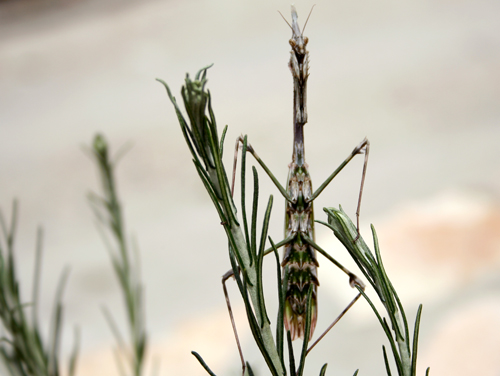
The plant, Helichrysum Italicum, is otherwise known as the ‘Curry Plant’. If there was one key note event in my early years it would be my parents taking me to Corsica when I was 10. I remember camping in large sandy river beds and the sun and aroma of masses of Helichrysum Italicum all around. Consequently it has been a plant I have always wanted to nurture in the garden but I have never had astounding success. However here at ‘Los Gazquez’ it grows naturally all around so I am in ‘Curry Plant’ heaven.
If there was another key note in my youth it would be my first encounter with a Praying Mantis and my minor obsession with them.
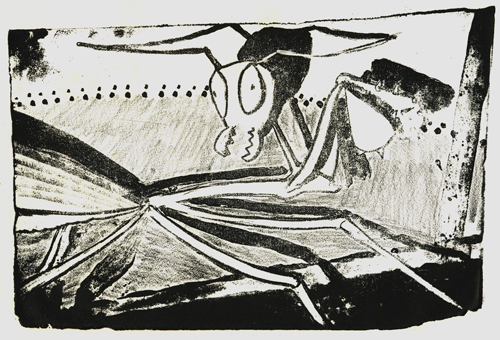
As a consequence of finding this specimin today, (Empusa pennata), and considering the content of my blog, I remembered that in the plan chest I have an old lithograph I made eons ago at the Royal Academy Schools. I never liked ‘print making’ much, and that is probably evident in my picture, but at least it is evidence of my slight obsession with them. Quite why this one is frozen in ‘limelight’ I cannot remember other than to recall a great influence from movers in the world of ‘magical realism’.
I love the camouflage of the variety in the photograph and how it’s sage green body fades to a china white head imitating the colour and form of it’s host plant. Beetles were on the menu, thankfully, as they are fornicating en masse and eating all the flowers.
Permalink
May 23, 2008 at 5:58 pm
· Filed under Vida los Velez
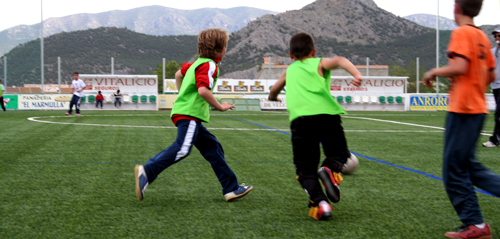
Fridays, from now on, the Velez Blanco team (the mountain team) can come down to Velez Rubio and play on the astroturf.
Astroturf eh!
Well, now in 2002 the world’s biggest gambling competition, Spain’s Christmas lottery, reached a climax with ‘El Gordo’ (the fat one) with a staggering 1.6 billion euros prize money to be won.
The winners came from all over Spain but the biggest single win came in Velez Rubio, a place the BBC describes as a dusty village of 4700 inhabitants, in the province of Almeria.
Velez Rubio’s amateur football club bought and then resold 80 first prize tickets, netting 160 million euros for their players, friends and supporters in the village and surrounding countryside.
And the chairman of the soccer club joked, that if all the prize money had gone to the club they could have bought Ronaldo three times over.
Now Solly can enjoy some of that prize money on Fridays (that’s him in the red top). Go on son, kick it.
Permalink
May 22, 2008 at 6:12 pm
· Filed under Visitors
Permalink
May 21, 2008 at 7:50 pm
· Filed under Environment

‘Splash and dash’ is the name given to the ‘corporate’ scam of businesses importing European produced biodiesel to the U.S. When in the U.S they ‘splash’ a little bit of their own biodiesel to the mix so that they are able to receive the government subsidy of approximatly 15 European cents per litre. They then ‘dash’ the biodiesel back to Europe undercutting E.U. production prices. And there is their profit margin. Effortless.
This is the kind of fuel that is supposed to be solving the world’s greenhouse gas problem. However, shipping the fuel back and forth across the Atlantic hugely increases it’s carbon footprint. Shipping equates to 5% of the world’s emissions which is double that of aviation and here is a fuel designed to save the planet’s climate and ends up contributing to it’s problems.
Biofuels need to be sustainable. They need to be the genuine product and not responsible for ‘rocketing’ global food prices as we rush to the next agrarian profit bonanza. The European Commission has been asked to address this problem with the U.S but as yet nothing has happened. M.E.P’s request that biofuel production should be made sustainable with legislation that makes all marketable biofuels ‘greener’ than the fuel they are replacing. With scams like these it seems unlikely to work.
It’s simply a scam and consequently un-ethical. You go to the petrol pump and those of us who try to be environmentally conscientious opt to pay more for the green option, but that is not what we are getting. What we get is a ‘virtual’ pollutant as it’s provenance is sullied.
Permalink
May 20, 2008 at 5:34 pm
· Filed under Architecture, Librarius
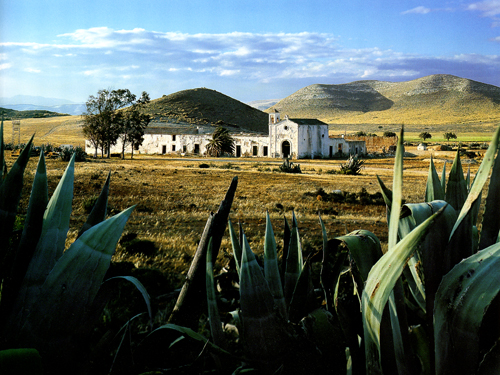
This picture is of Cortijo del Fraile, Nijar and is taken from a fantastic book called ‘Cortijos, haciendas and lagares’ in the province of Almeria. It’s a book published by the ‘Junta de Andalucia’ to celebrate the agrarian vernacular architecture and lifestyle of old and it is a gem. It is full of ‘plan’ drawings representing the relationship of farm buildings to each other and satellite pictures illustrating the lie of the land and explanations as to how these old farming systems operated.
To our great joy ‘Cortijada Los Gazquez’ is in here but alas in no detail. It is there as an illustration to compare and contrast the different architectural styles employed to deal with the climatic differences between the ‘desert’ land of southern Almeria and the mountains to the north.
Sadly most of these buildings are crumbling into extinction with just a handful in use. Happily for us ours is restored and will once again work as a farm building in our alpine desert.
Permalink
May 19, 2008 at 6:38 pm
· Filed under Environment
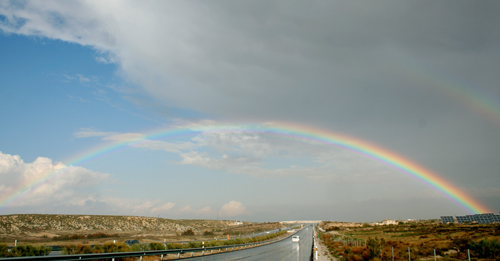
The tanker Sichem Defender arrived at the port of Barcelona yesterday carrying something far more precious than its usual cargo of chemicals. Nearly 23m litres of drinking water - enough for 180,000 people for a day - was the first delivery in an unprecedented emergency plan to help this parched corner of Spain ahead of the holiday season.
The Guardian
I actually cribbed this quote from ‘Notes from Spain’ (see blogroll on the right), not having that Madridliano benefit of being able to buy my own copy of the Guardian. Not even for the crossword.
However this domestic water shortage situation is something that exists nearly everywhere in the world. Even wet Britain. If the UK benefits from a few weeks of sunshine before you know it there is a hosepipe ban. We know the reason why, so we don’t need to discuss it. What we should address though is the reason why so many of us miss out on benefiting from a natural resource bouncing on our roof tiles and pouring away into the water table just for some other body to access it and sell it back to us.
There is a simple device commonly used in norther Europe, but minimally here in Spain, called guttering. However, as we made the environmentally disastrous decision to transport sewage from our homes using water we also decided to contribute to this disaster by adding our harvested rainwater to the same system.
The simple truth is (and this especially applies to new buildings) there is a correlation between the number of inhabitants of a building (i.e. their water consumption), the average rainfall for the buildings location, the size of it’s roof and the size of a rainwater deposit. It is more or less feasible to store sufficient rainwater at a house to provide sufficient water for the house’s annual consumption. And what is more you would reduce your carbon footprint (if the design was good) by not having to pump this water around your building.
What is more, tangentially speaking, there is a correlation between climate, roof size and amenable interior environments. Basically in hot climates you would require a large roof to harvest lower amounts of annual rainfall but at the same time you create greater amounts of shade and air movement. Contrarily, higher annual rainfalls require smaller roofs and create a higher interior access to sunlight. (Coming from the ‘Dark Peak’ that’s something I know all about.)
I’ll have more to write on this subject as we assess the pros and cons of our own rainwater harvesting system. Nothing is straight forward and nothing should be taken for granted either in our changing world.
Permalink

















